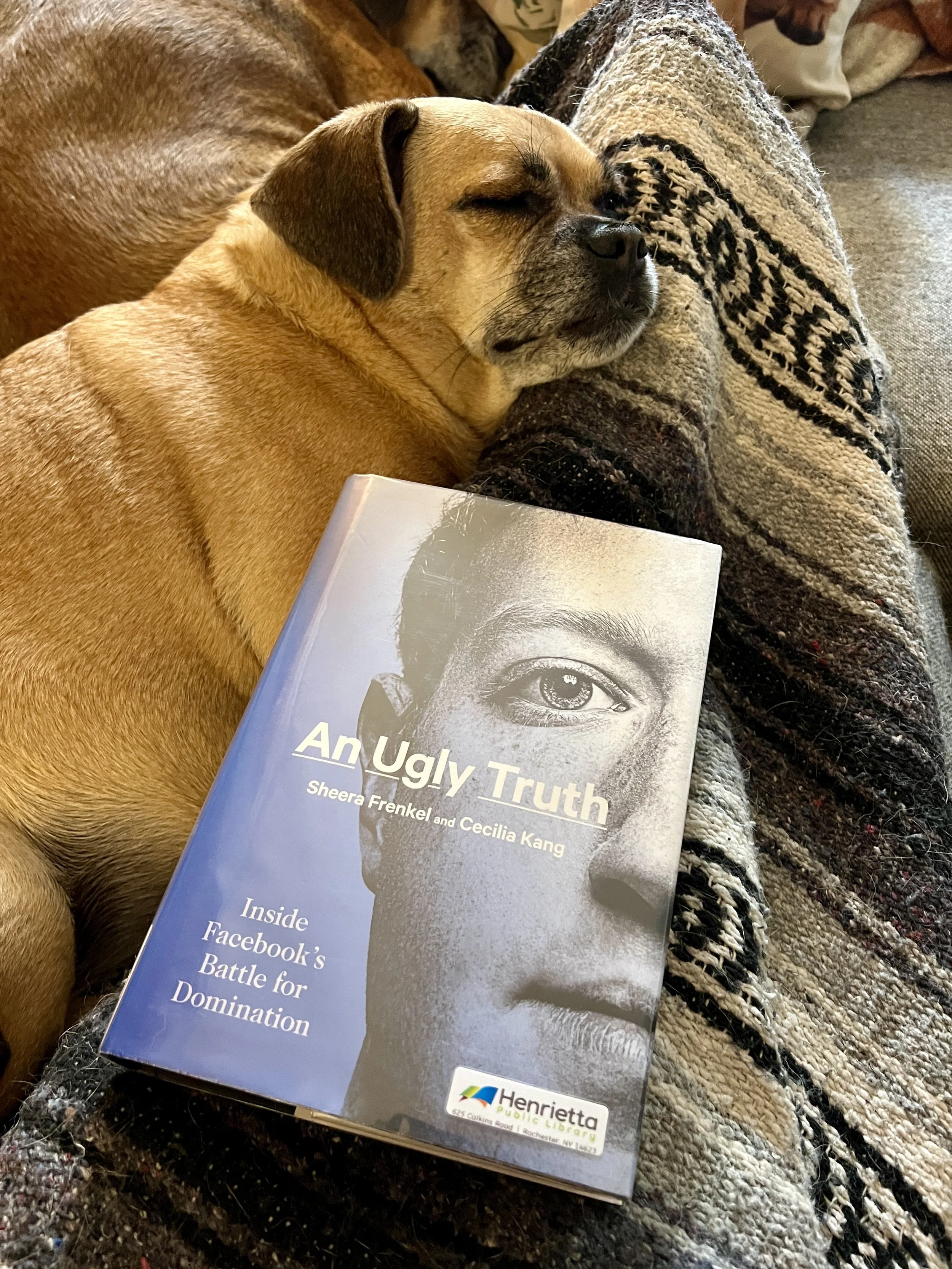5 Books About How Social Media Shapes Our Culture & World
/This fall, I’m teaching a college-level social media course at Nazareth University. The students and I are both learning lots, and it’s been a great experience so far! The midterm project I assigned was pretty unconventional for a social media class: the students had to read a book about social media from a list of five suggested titles and then review it in a traditional paper and an Instagram post or TikTok. My goal was to encourage them to think critically about the platforms we use every day in our professional and personal lives. It was fascinating to read my students’ observations, discuss the books as a class, and see the intersections between them! Today on the blog, I’m sharing a little about each book and what it tells us about the myriad ways that social media shapes our culture and our world.
1) An Ugly Truth: Inside Facebook’s Battle for Domination by Sheera Frenkel and Cecilia Kang (2021)
An Ugly Truth still feels shockingly relevant in 2023. A core conflict at the heart of Facebook past and present is: what is considered ‘free speech’? How much content moderation is fair and necessary? Does free speech include the right to lie? For Facebook, it did. They refused to fact check political ads for years, allowing misinformation to run rampant. As the content moderation versus free speech debates rage on in 2023 (including at the Supreme Court level), it’s concerning to read that Zuckerberg grossly underestimates the complexity of speech still. He believes it’s perfectly feasible for all content moderation to be handled by AI, though time has shown that AIs miss nuance that humans pick up on.
Another troubling theme is that whenever someone spoke up to Zuckerberg about problematic implications of his technology that he had not yet considered, he would either ignore complaints, dismiss them as trivial, or gaslight folks into thinking they were crazy for even suggesting there could be a problem. Some of the earliest complaints came from Latinx and Black women at Harvard who told him that what he was doing with FaceMash was messed up. Unsurprisingly, he did not listen. Later on, other Facebook employees would later point out that, “being proactive was not always appreciated” (Frenkel 119). Why engage in fire prevention measures when the fire might not even happen? Sigh.
This book is essentially a parade of alarming information about Facebook–none of it terribly surprising, but all of it worrying. Even in the earliest days of Facebook, Zuckerberg designed the platform as a place to waste time and reveal things about yourself. He wanted nothing more than data, knowing that data equals power. Frenkel and Kang expertly show that Facebook will always put their own platform and profit above everything else, including their users and even democracy. Their writing style is compelling, fueled by cringe-inducing sound bites from industry insiders. Ultimately, An Ugly Truth is a clear indictment of a platform that billions of people use daily. Facebook has a problem with doing the right thing, and that isn’t going to change anytime soon. The effects will likely continue to be disastrous.
2) No Filter: The Inside Story of Instagram by Sarah Frier (2020)
No Filter was one of the most popular books with my students! Everyone who read it thoroughly enjoyed it. In teaching this class, I’ve learned that not every Gen Zer is TikTok-obsessed; the majority consider Instagram their favorite platform and spend the most time there.
This book fits right in with Frenkel and Kang depiction of Zuckerberg as desperate to dominate; Frier’s version of him is almost cartoonishly evil. On the flip side, her version of Instagram’s founders is scrappy, authentic, and inspiring. I wish she had been a bit more critical of them. Frier interviewed numerous Instagram employees, celebrities, and users in order to lay out clearly how Instagram has shaped our world. From creating Instagrammable spaces and experiences to influencing the fashion industry to the rise of influencer culture and the personal brand, Instagram has had a massive impact.
I would love to see an updated version of this book given that so much has happened since it was published in 2020; my views on Instagram have changed significantly since then. The app used to be a fun way to connect with other people who were passionate about the same things as you. Now when I think of Instagram, I think of conspiracy theories on pink graphics, the crunchy-to-alt-right pipeline, tradwives, and the endless push to share Reels instead of still photos. Instagram is struggling in the TikTok era as it tries to be all things to all people and crush the competition. It’s lost sight of what it was truly good at.
3) Subprime Attention Crisis: Advertising and the Time Bomb at the Heart of the Internet by Tim Hwang (2020)
Subprime Attention Crisis was a very technical read; my students and I both found it somewhat challenging. I found Hwang’s argument weak and unconvincing in the end. Hwang has a deep understanding of the digital advertising ecosystem and automated bidding process. He argues that digital ads are vastly overvalued. Despite there being more data than ever before that we can measure, it’s not good data. Knowing how many people the ad was served to doesn’t tell you where the ad was placed, if they’re using an ad blocker, or if they actively paid attention to your ad. Sure, we don’t know any of those things with billboards, but the online advertising industry acts like digital ads are the be-all, end-all, with incredible power and endless possibilities. The power and possibilities aren’t all they’re cracked up to be. Hwang claims it was a terrible idea to build the entire internet around digital advertising.
I was with him that far.
He goes on to argue that this has created a bubble that will inevitably burst, sooner rather than later. Three years later, this doesn’t ring true. Wouldn’t the bubble have burst by now? He makes valid points about the data not being all it’s hyped up to be, but he spends more of the book exploring the what ifs of a crash rather than explaining the likelihood of a crash. In my opinion, industry professionals are too bought into the system to tear it down or worry about a bubble bursting. It benefits advertisers to keep running these ads. It benefits tech companies to keep profiting off them. Why would they slow down or restructure the internet? I don’t think that’s cynical, just realistic. Things will only crumble if people lose faith in the system, and lots of people are good at chugging away under a system that benefits them.
4) Because Internet: Understanding the New Rules of Language by Gretchen McCulloch (2019)
Because Internet was another student favorite! McCulloch writes in a fun and accessible tone, so I think that made it resonate. She dives deep into internet writing in a way that makes the book come alive, full of entertaining examples of emojis, memes, silly phrases, and more, illuminating how they work and why. I found this book insightful about how we communicate online and why it’s evolved in the ways it has. It also felt refreshing to have social media and online culture taken seriously when older generations often scoff at it!
This book is from 2019 and feels somewhat dated, particularly because online communication changes so quickly. Trends come and go, the meaning of memes evolves, and ultimately, it’s a snapshot in time. Nonetheless, it remains a valuable, informative, and entertaining read.
5) The Influencer Industry: The Quest for Authenticity on Social Media by Emily Hund (2023)
While this book has a lovely cover, its contents are dry and academic. My students struggled with it (and I did too at times), but in the end, it provided interesting historical context and thoughtful recommendations about the industry’s future. It’s great to see that academic researchers are taking an interest in the impact influencers have on society and culture–because it’s significant.
Hund lays out how the influencer industry arose out of the Great Recession, which I didn’t realize. It was striking to read this in 2023, with inflation so high and so many folks struggling to get by–I can see why influencer work continues to be desirable. So many people are not able to make ends meet working just one job, so they turn to monetizing their personality and daily life in an effort to earn extra cash.
From there, Hund explains how influencers became industrialized and authenticity became a commodity. Brands and marketers found it incredibly valuable to have relatable, everyday people sharing about their product, seemingly ‘authentically.’ But those influencers have a difficult tightrope to walk, trying to appear relatable and honest, while also marketing a multitude of products that may or may not truly be ‘on-brand’ for them.
Hund also reveals the numerous problems with the industry. There’s little pay transparency since there is no standardization. Now, brands are moving toward hiring micro- or nano-influencers as they will often work in exchange for free products, making campaigns cheaper and leaving larger influencers without work they rely on. Additionally, there is a sizable pay gap between influencers of color and their white counterparts. It’s unsurprising, but it’s valuable to have documented in an academic text.
Ultimately, Hund argues for a few things to strengthen the industry before the impact of influencers starts to do more harm than good:
Influencers should unionize to advocate for pay transparency, closing the pay gap, and better compensation.
There should be an influencer code of ethics that guides their behavior, prohibiting things like spreading misinformation.
The U.S. government should work to better understand the industry so they can regulate it properly. If they don’t, just like we saw with Facebook in An Ugly Truth, they may spread unchecked misinformation that starts to erode the foundation of our democracy.
For more bookish content, check out these blog posts:
Looking for your next great read? Check out my curated book recommendations!





